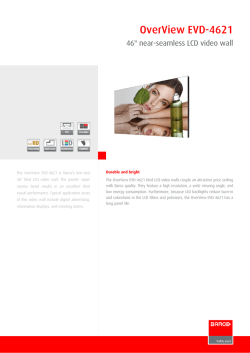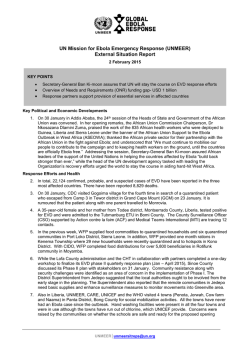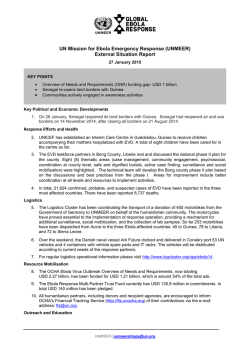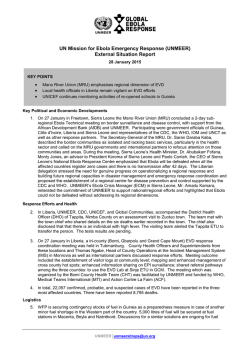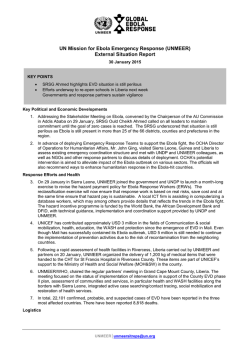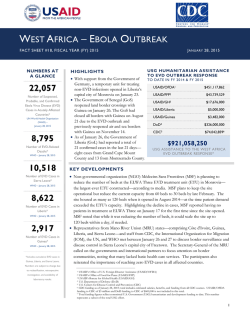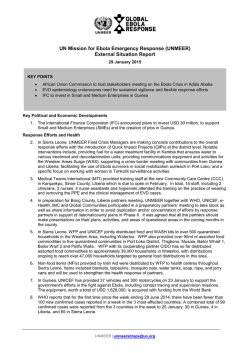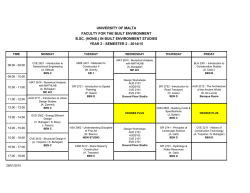
Meningitis Caused by Multidrug Resistant Acinetobacter baumannii
內科學誌 2014:25:436-445 Meningitis Caused by Multidrug Resistant Acinetobacter baumannii: an Emerging Threat for Neurosurgical Patients Chang-Hua Chen1, Yu-Min Chen2, and Chun-Yuan Cheng3 1Division of Infectious Disease, Department of Internal Medicine; 2Department of Pharmacy, 3Division of Neurosurgery, Department of Surgery, Changhua Christian Hospital, Changhua; Taiwan Abstract Acinetobacter baumannii (A. baumannii) infection is a common clinical problem in critically ill patients, but it’s still rare after neuro-surgical operation. We reported two cases of A. baumannii meningitis after neurosrugical operation. Both two cases highlight the importance of repairing all dural tears and A. baumannii becomes an emerging threat for post-neurosurgical patients. The urgent need for increasing the awareness A. baumannii meningitis among the neuro-surgical wards cannot be over emphasized. (J Intern Med Taiwan 2014; 25: 436-445) Key Words: Acinetobacter baumannii, Multidrug resistant, Meningitis, Neuro-surgical patient reported8,9. After reviewing the literatures, the Background acinetobacter meningitis after neuro-surgical opera- Acinetobacter baumannii (A. baumannii) has tion is actually not so rare. Also, multidrug resis- emerged as a significant nosocomial pathogen in tance is a relatively common occurrence among worldwide1-2. Although infec- these organisms, and the definition of multidrug tions with Acinetobacter spp. occur infrequently, resistance A. baumanii is according to Magiorakos’s the incidence continues to increase. Acinetobacter report in this study10. A. baumannii meningitis is a spp. can cause a multitude of infections, including serious condition that yields high rates of mortality meningitis3. and morbidity11-12. hospitalized patients Mortality rates from 12% to 70% were reported from studies that evaluated Gram-negative meningitis4,5. In central Taiwan as well as the world, there Some authors had described was the emerging multidrug resistant A. baumannii the outbreaks of nosocomial postoperatively menin- meningitis11. Here, we reported first two cases gitis6,7. Also, A. baumanii meningitis after durotomy of A. baumannii meningitis after neuro-surgical and after ventriculoperitoneal shunt insertion was operation in our institute. bacillary Reprint requests and correspondence:Dr. Chang-Hua Chen Address:Section of Infectious Diseases, Department of Internal Medicine, Changhua Christian Hospital, No. 135 Nanhsian Street, Changhua 500, Taiwan Multidrug Resistant Acinetobacter baumannii Meningitis for Neurosurgical Patients 437 (imipenem-cilastatin and meropenem); and resistant Case one presentation A 39 year-old healthy male visited to our emer- to cefmetazole, cefotaxime, ceftazidime, cefepime, cefpirome, gentamicin, amikacin, ampicillin, gency department because of accident trauma, and amoxicillin-clavulanate, piperacillin, ciprofloxacin, he presented with four limbs paralysis, and sensory and trimethoprim-sulfamethoxazole. We exchange loss. The cervical spinal injury was suspected, and to the imipenem-cilastatin 500mg every 6 hours. he was admitted to surgical intensive care unit. During the hospitalization, the serial microbiolog- Upon admission, he was afebrile, with a blood pres- ical studies showed no more A. baumannii growth sure of 120/80 mmHg. The magnetic resonance in his follow-up sample. He received the 21-days imaging (MRI) of the spine showed that abnormal imipenem-cilastatin. The serial follow-up labora- bony alignment of the lower cervical spine due to tory data normalized. He was discharged on 63th grade II traumatic spondylolisthesis, C6 over C7 admission days. level, the mal-alignment bony structure and posterior disks protrusion cause severe C6/7 level central Case two presentation canal narrowing and deformity; the resultant ventral A 32 year-old female presented with blurred thecal sac and cord compression are also noted; there vision progressively. She denied any discomforts is focal high signal change seen on the T2WI in the before. She visited the ophthalmologist of our insti- C6/7 level; acute traumatic cord edematous change tute. The visual accurate was 0.2 (left eye), and is compatible. The C6-7 fracture and subluxation 0.6 (right eye), but significant hemi-agnosia was with cord injury was impressed. The C6-7 dissec- disclosed on her visual filed examination. Optic tomy and anterior fusion with autollogous bone graft neuropathy was suspected, and the brain MRI was was performed on 4th admission day. His condi- arranged. The contrast enhanced and non-contrast tion was stationary but he depended the ventilator MRI study of the brain showed the followings: One because of respiratory failure. Fever occurred since large tumor with intermediate T1 signal and high 30th admission day, but the surgical site seemed no T2 signal, involving the sella turcica and suprasellar sign of local inflammation, urinalysis was normal, cistern. There is large cystic/necrotic part within the and his chest film did not have pneumonic patch. tumor. After contrast medium administration, the No obvious infectious focus was disclosed, lumbar tumor shows strong enhancement. The tumor size is puncture was performed to exclude the menin- about 3.7 x 2.6 x 2.6 cm. The tumor compresses the gitis. The cerebral spinal fluid (CSF) examination optic chiasm upward. There is no evidence of brain revealed white cell count: 1120 /cmm, N/L: 83/15; infarction. The finding is consistent with pituitary protein 192 mg/dL (normal range 15-45 mg/dL); macroadenoma. The trans-sphenoidal approach glucose: 2 mg/dL (normal range: 40-70 mg/dL). (left nostril) with partial removal of the tumor was CNS infection was suspected, and the vancomycin arranged the 2nd admission day. The pathological 1000mg every 12 hours plus ceftazidime 2000mg results reported that the adenoma of the pituitary every 8 hours was prescribed. A. baumannii was gland. On 1st post-operation day, she complained isolated on CSF culture three days later. The of mild rhinorrhea, vomiting, and dizziness. Brud- A. baumannii was identified with an API 20NE zinski’s sign and Kernig’s sign were positive. The strip (BioMérieux, Durham, N.C.). We performed CSF examination revealed white cell count: 3220/ the susceptibility test of that A. baumannii stain. cmm, N/L: 88/9; protein 999 mg/dL (normal range The results were only susceptible to carbapenem 15-45 mg/dL); glucose: 1 mg/dL (normal range: C.H. Chen, Y.M. Chen, and C.Y. Cheng 438 40-70 mg/dL). The CSF leakage with infection was suspected. The vancomycin 1000mg every 12 hours plus ceftazidime 2000mg every 8 hours was prescribed. A. baumannii was isolated on CSF culture two days later. The A. baumannii was identified with an API 20NE strip (BioMérieux, Durham, N.C.). We performed the susceptibility test of that A. Table 1. Literature review for predisposing factors and treatment of post-neurosurgical Acinetobacter baumannii Meningitis Variable Range Overall patients numbers 49 Age, median (range) 38 (2 mo-74 years) Sex, male (%) 26/49(53.1%) baumannii stain. The results were only susceptible to Underlying disease (s) (%) carbepenem (imipenem-cilastatin and meropenem); SAH 18(36.7%) and resistant to cefmetazole, cefotaxime, ceftazi- HT 12(24.5%) dime, cefepime, cefpirome,gentamicin, amikacin, HC 10(20.4%) ampicillin, amoxicillin-clavulanate, piperacillin, MNGoma 6(12.2%) ciprofloxacin, and trimethoprim-sulfamethoxazole. Aneurysm 6(12.2%) ICH 3(6.1%) Choroid plexus papilloma 2(4.1%) Medulloblastoma 1(2%) Ependymoma 1(2%) tatin. The serial follow-up laboratory data normal- Artery dissection 1(2%) ized. She was discharged on 35th hospitalized days. BI 1(2%) She was follow-up at outpatient department, and HTN 1(2%) she recovered well. Subdural haematoma 1(2%) Haemangioblastoma 1(2%) We exchange to the imipenem-cilastatin 500 mg every 6 hours accordingly. During the hospitalization, the serial microbiological studies showed no more A. baumannii growth in her follow-up samples. She received the 26-days imipenem-cilas- Discussion We reported first two cases of A. baumannii Predisposing factors (%) EVD 40(81.6%) VP shunt 5(10.2%) Post-neurosurgical procedure1 4(8.2%) ELD 4(8.2%) literature review with the keywords “Acinetobacter Plastic meningeal prosthesis 2(4.1%) baumannii”, “meningitis”, “operation”, “central Ommaya reservoir 1(2%) nervous system infection”, “neuro-surgical opera- Coil replacement 1(2%) tion”, and “resistant”. Only post-neurosurgical LP 1(2%) procedure and A. baumannii meningitis were Aneurysm clips 1(2%) enrolled. Fourty-nine patients with post-neuro- FATD, median(range), Days 15(1-82) meningitis after neuro-surgical operation in our institute. Because A. baumannii meningitis has been rarely suggested as a cause of central nervous system infection, we conducted an evidence-based surgical A. baumannii meningitis were reported worldwide (Table)13-35. The clinical manifestations of A. baumannii meningitis were variable. The crude mortality rate of A. baumannii bacteremia was 10.5% at our institute11, but there is no data for mortality rate of A. baumannii meningitis at Final regimen (%) CMS monotherapy 30(61.2%) CMS based combination 15(30.6%) CAR2 monotherapy 2(4.1%) CAR2 based combination therapy 7(14.3%) Multidrug Resistant Acinetobacter baumannii Meningitis for Neurosurgical Patients Table 1. Continued 439 A. baumannii meningitis post neuro-surgical opera- Variable Range tion, and they were survival. The possible source of DOEA, median(range), Days 27 (21-56) those two cases with A. baumannii meningitis may Outcome, survival (%) 46/49(93.9%) be from either the device or the invasive proce- Notes 1 Post-neurosurgical procedure included coil replacement, trans-sphenoidal biopsy. 2 Carbepenem included meropenem and imipenem-cilastatin The table were summarized from references13-35. Abbreviation: BI: Brain infarction; CAR: carbepenem; CMS, colistin methanesulfonate; DOEA, duration of effective antibiotics; ELD, external lumbar drain; EVD, external ventricular drainage; FATD: from admission to diagnosis; HT: head trauma; HTN, hypertension; ICH, intracerebral haemorrhage; LP, lumbar puncture; MNGoma: Meningioma; SAH, subarachnoid haemorrhage; VP, ventriculoperitoneal shunt. dures, or environment or the vicious cycle from the healthcare staff. And the A. baumannii went into the meningeal through the defect of the dural. Although many cases had been reported, it needed the further examination to prove this hypothesis. One of the most striking features of acinetobacter species is their extraordinary ability to develop multiple resistance mechanisms against major antibiotic classes. In acinetobacter meningitis, the major problems confronting clinicians in intensive care units are related to the severity of acinetobacter noso- our institute because of few cases. In last decade, comial infections and to resistance to major antibi- Baltas’s study for the post-traumatic meningitis otic classes of these organisms38. Both of those two reported 12 of 860 patients deveoped the complica- A. baumannii were multidrug-resistant strains, but tion after traumatic injury, and the infecting agents we treated successfully with carbapenem. In order were Gram-negative bacilli in six patients (Esch- to study the treatment, we summarzed the litera- erichia coli in two, Klebsiella pneumoniae in two, tures at Table. Colistin had been widely prescribed and Acinetobacter anitratus in two)36. Since the to treat multi-resistant A. baumannii meningitis in decade, a remarkable increase in the incidence of nowadays. Concerning the therapy of drug-resistant nosocomial Gram-negative infections, especially A. baumannii meningitis, Karaiskos reported intra- A. baumannii, had been observed. These pathogens ventricular and intrathecal colistin represents the represented a substantial problem in clinical prac- last resort treatment of MDR A. baumannii ventric- tice because of both susceptible to the immuno- ulitis and meningitis, offering a unique, rather safe compromized hosts and the high resistance profile and successful mode of therapy3. Lu suggested that of most commonly used antibiotics37. These current early initiation of appropriate antibiotic therapy is two A. baumannii meningitis after neuro-surgical needed for those adult post-neurosurgical patients in operation were testimony. this potentially fatal disease39. Those two cases with To study the possible predisposing factors, we summarized the literatures at Table and Appendix. A. baumannii meningitis were successfully treated with intravenous carbapenem. The predisposing factors included external ventric- A. baumannii infection is a common clinical ular drain (44 patients), ventriculoperitoneal shunt problem in critically ill patients, but it’s still rare and (5 patients), plastic meningeal prosthesis (2 patients), severe after neuro-surgical operation. We reported Post-neurosurgical procedure (2 patients), Ommaya two cases of A. baumannii meningitis after neuro- reservoir (1 patient), coil replacement (1 patient), srugical operation. The urgent need for increasing and trans-sphenoidal biposy (1 patietn). Ninty-three the awareness the A. baumannii meningitis among percent among 48 patients (Fourty-six episodes) the neuro-surgical wards cannot be over emphasized. were survived. Here we reported two cases with 440 C.H. Chen, Y.M. Chen, and C.Y. Cheng References 1. Allen DM, Hartman BJ. Acinetobacter Species. In: Mandell GL, Bennett L. Kasper, Eugene Braunwald, Anthony S. Fauci, Stephen L. Hauser, Dan JE, Dolin R.eds. Principles and Practice of Infectious Diseases. 6th ed. Philadelphia: Churchill Livingstone 2005; 2632-6. 2. Schreckenberger PC & von Graevenitz A: Acinetobacter, Alcaligenes, Moraxella, Methylobacterium and Other Nonfementative Gram-Negative Rods. In: Murray PR, Baron EJ, Pfaller MA, Tenover FC, Yolken RH, eds. Manual of Clinical Microbiology. 7th ed. Washington, D.C. ASM Press 1999; 539-51. 3. Karaiskos I, Galani L, Baziaka F, Giamarellou H. Intraventricular and intrathecal colistin as the last therapeutic resort for the treatment of multidrug-resistant and extensively drugresistant Acinetobacter baumannii ventriculitis and meningitis: a literature review. Int J Antimicrob Agents 2013; 41: 499-508. 4. Garcia-Garmendia JL, Ortiz-Leyba C, Garnacho-Montero J, et al. Risk factors for Acinetobacter baumannii nosocomial bacteremia in critically ill patients: a cohort study. Clin Infect Dis 2001; 33: 939-46. 5. Metan G, Alp E, Aygen B, Sumerkan B. Acinetobacter baumannii meningitis in post-neurosurgical patients: clinical outcome and impact of carbapenem resistance. J Antimicrob Chemother 2007; 60: 197-9. 6. Gulati S, Kapil A, Das B, Dwivedi SN, Mahapatra AK. Nosocomial infections due to Acinetobacter baumannii in a neurosurgery ICU. Neurol India 2001; 49: 134-7. 7. Wroblewska MM, Dijkshoorn L, Marchel H, et al.Outbreak of nosocomial meningitis caused by Acinetobacter baumannii in neurosurgical patients. J Hosp Infect 2004; 57: 300-7. 8. deFreitas DJ, McCabe JP. Acinetobacter baumanii meningitis: a rare complication of incidental durotomy. J Spinal Disord Tech 2004; 17: 115-6. 9. Kralinsky K, Krcmeryova T, Tuharsky J, Krcmery V. Nosocomial Acinetobacter meningitis. Pediatr Infect Dis J 2000; 19: 270-1. 10. Magiorakos AP, Srinivasan A, Carey RB, Carmeli Y, Falagas ME, Giske CG, et al. Multidrug-resistant, extensively drugresistant and pandrug-resistant bacteria: an international expert proposal for interim standard definitions for acquired resistance. Clin Microbiol Infect 2012; 18: 268-81. 11. Chen CH, Lin LC, Chang YJ, Huang CC, Liu CE, Young TG. Analysis of prognostic factors in 95 patients with Acinetobacter baumannii bacteremia. Infection 2003; 31: 331-5. 12. Roos KL ,Tyler KL. Bacterial Meningitis and Other Suppurative Infections. In: Braunwald E, Fauci AS, Hauser SL, Longo DL, Jameson JL, and Kasper DL. eds. Harrison’s Principles of Internal Medicine. 15th ed. New York: McGraw-Hill 2004; 2462-71. 13. Fernandez-Viladrich P, Corbella X, Corral L, Tubau F, Mateu A. Successful treatment of ventriculitis due to carbapenemresistant Acinetobacter baumannii with intraventricular colistin sulfomethate sodium. Clin Infect Dis 1999; 28: 916-7. 14. Vasen W, Desmery P, Ilutovich S, Di Martino A. Intrathecal use of colistin. J Clin Microbiol 2000;38:3523. 15. Benifla M, Zucker G, Cohen A, Alkan M. Successful treatment of Acinetobacter meningitis with intrathecal polymyxin E. J Antimicrob Chemother 2004; 54: 290-2. 16. Sueke H, Marsh H, Dhital A. Using intrathecal colistin for multidrug resistant shunt infection. Br J Neurosurg 2005; 19: 51-2. 17. Bukhary Z, Mahmood W, Al-Khani A, Al-Abdely HM. Treatment of nosocomial meningitis due to a multidrug resistant Acinetobacter baumannii with intraventricular colistin. Saudi Med J 2005; 26: 656-8. 18. Kasiakou SK, Rafailidis PI, Liaropoulos K, Falagas ME. Cure of post-traumatic recurrent multiresistant Gram-negative rod meningitis with intraventricular colistin. J Infect 2005; 50: 348-52. 19. Charra B, Hachimi A, Benslama A, Motaouakki A. Intrathecal use of colistin. Ann Fr Anesth Reanim 2006; 25: 215 [in French]. 20. Ng J, Gosbell IB, Kelly JA, Boyle MJ,Ferguson JK. Cure of multiresistant Acinetobacter baumannii central nervous system infections with intraventricular or intrathecal colistin: case series and literature review. J Antimicrob Chemother 2006; 58: 1078-81. 21. Al Shirawi A, Memish ZA, Cherfan A, Al Shimemeri A. Postneurosurgical meningitis due to multidrug-resistant Acinetobacter baumannii treated with intrathecal colistin: case report and review of the literature. J Chemother 2006; 18: 554-8. 22. Paramythiotou E, Karakitsos D, Aggelopoulou H, Sioutos P, Samonis G, Karabinis A. Post-surgical meningitis due to multiresistant Acinetobacter baumannii. Effective treatment with intravenous and/or intraventricular colistin and therapeutic dilemmas. Med Mal Infect 2007; 37: 124-5. 23. Ho YH, Wang LS, Chao HJ, Chang KC, Su CF. Successful treatment of meningitis caused by multidrug-resistant Acinetobacter baumannii with intravenous and intrathecal colistin. J Microbiol Immunol Infect 2007; 40: 537-40. 24. Lee CH, Tang YF, Su LH, Chien CC, Liu JW. Antimicrobial effects of varied combinations of meropenem, sulbactam, and colistin on a multidrug-resistant Acinetobacter baumannii isolate that caused meningitis and bacteremia. Microb Drug Resist 2008; 14: 233-7. 25. Hachimi A, Charra B, Benslama A, Motaouakki S . Intrathecal use of amikacin and colistin. Ann Fr Anesth Reanim 2008; 7: 113-4 [in French]. 26. Dalgic N, Ceylan Y, Sancar M, et al.Successful treatment of multidrug-resistant Acinetobacter baumannii ventriculitis with intravenous and intraventricular colistin. Ann Trop Paediatr 2009; 29: 141-7. 27. Lopez-Alvarez B, Martin-Laez R, Farinas MC, PaterninaVidal B, Garcia-Palomo JD,Vazquez-Barquero A. Multidrugresistant Acinetobacter baumannii ventriculitis: successful treatment with intraventricular colistin. Acta Neurochir (Wien) 2009; 151: 1465-72. 28. Cascio A, Conti A, Sinardi L, et al. Post-neurosurgical multidrug-resistant Acinetobacter baumannii meningitis Multidrug Resistant Acinetobacter baumannii Meningitis for Neurosurgical Patients successfully treated with intrathecal colistin. A new case and a systematic review of the literature. Int J Infect Dis 2010; 14: e572-9. 29. Khawcharoenporn T, Apisarnthanarak A, Mundy LM. Intrathecal colistin for drug-resistant Acinetobacter baumannii central nervous system infection: a case series and systematic review. Clin Microbiol Infect 2010; 16: 888-94. 30. De Pascale G, Pompucci A, Maviglia R, et al. Successful treatment of multidrug-resistant Acinetobacter baumannii ventriculitis with intrathecal and intravenous colistin. Minerva Anestesiol 2010; 76: 957-60. 31. Ozdemir H, Tapisiz A, Ciftçi E, et al. Successful treatment of three children with post-neurosurgical multidrug-resistant Acinetobacter baumannii meningitis. Infection 2010; 38: 241-4. 32. Kim K, Kang H, Sohn CH, Oh BM. Cauda equina syndrome misdiagnosed as aggravated hydrocephalus: neurological complication of intrathecal colistin in post-surgical meningitis.Acta Neurochir (Wien) 2011; 153: 425-7. 33. Patel JA, Pacheco SM, Postelnick M, Sutton S. Prolonged triple therapy for persistent multidrug-resistant Acinetobacter baumannii ventriculitis. Am J Health Syst Pharm 2011; 68: 1527-31. 441 34. Wang JH, Lin PC, Chou CH, et al. Intraventricular antimicrobial therapy in postneurosurgical Gram-negative bacillary meningitis or ventriculitis: A hospital-based retrospective study. J Microbiol Immunol Infect 2014; 47: 204-10. 35. Karaiskos I, Galani L, Baziaka F, et al. Successful treatment of extensively drug-resistant Acinetobacter baumannii ventriculitis and meningitis with intraventricular colistin after application of a loading dose: a case series. Int J Antimicrob Agents 2013; 41: 480-3. 36. Baltas I, Tsoulfa S, Sakellariou P, Vogas V, Fylaktakis M, Kondodimou A. Posttraumatic meningitis: bacteriology, hydrocephalus, and outcome. Neurosurgery 1994; 35: 422-6 37. Weinstein RA. Infection Control in the Hospital. In: Braunwald E, Fauci AS, Hauser SL, Longo DL, Jameson JL, and Kasper DL. eds. Harrison’s Principles of Internal Medicine. 15th ed. New York: McGraw-Hill 2004; 853-7. 38. Bergogne-Berezin E. The Increasing Role of Acinetobacter Species As Nosocomial Pathogens. Curr Infect Dis Rep 2001; 3: 440-4. 39. Lu CH, Chang WN, Chuang YC, Chang HW. Gram-negative bacillary meningitis in adult post-neurosurgical patients. Surg Neurol 1999; 52: 438-43. 多重抗藥性包氏不動桿菌腦膜炎: 神經外科病患術後的危機 陳昶華 1 陳昱旻 2 鄭均垣 3 彰化基督教醫院 感科內科 1 藥劑部 2 神經外科 3 摘 要 包氏不動桿菌腦膜炎是在神經外科病患術後重要的感染症,我們描述了兩個案例。兩例 都凸顯出神經外科病患手術時,腦膜會被剝開然後縫合,包氏不動桿菌趁虛而入感染為腦膜 炎。在神經外科需要提防神經外科病患術後的包氏不動桿菌腦膜炎。 Fernandez- Viladrich et al., 1999, Spain[13] Fernandez- Viladrich et al., 1999, Spain[13] Vasen et al., 2000, Argentina [14] Benifla et al., 2004, Israel [15] Glesson T, et al, 2005, USA[15] Sueke et al., 2005, UK [16] Bukhary et al., 2005, Saudi Arabia [17] Kasiakou et al., 2005, Greece [18] Kasiakou et al., 2005, Greece (2nd episodes) [18] Charra et al., 2006, Morocco [19] Ng et al., 2006, Australia [20] Ng et al., 2006, Australia[20] Ng et al., 2006, Australia[20] Ng et al., 2006, Australia[20] Ng et al., 2006, Australia[20] 1 2 3 4 5 6 7 8 9 10 11 12 13 14 15 Authors, year, country [Reference] 4/M 26/M 38/F 56/F 74/F 36/M 28/M 28/M 23/F 38/F 37/F 49/F 41/F 34/F 16/M Age (years)/sex Medulloblastoma ICH HT SAH/HC SAH/HC HT HT, recurrent MNG HT, recurrent MNG MNGoma Sepsis, HC, HT NR Recurrent MNGoma, recurrent episodes of MNG SAH/HC SAH/HC Haemangioblastoma of 4th ventricle Underlying disease(s) Post-neurosurgical procedure EVD EVD EVD EVD EVD Plastic meningeal prosthesis, EVD Plastic meningeal prosthesis, EVD EVD VP shunt externalised and removed, EVD Post-neurosurgical procedure VP shunt externalised EVD, aneurysm clips EVD EVD Predisposing factors CMS IV CMS IV, CMS IT MEM,AMK, RIF, IV SAM and VAN IV, CMS IV CMS IT TOB IV and CMS IV TOB IV and CMS IV Final regimen Susceptible to CST and AMK; CMS, AMK and intermediate to IPM and MEM TEC, IV Susceptible to CST Susceptible to CST susceptibility to IPM, SAM Susceptible to CST and SUL Susceptible to CST Susceptible to CST; intermediate to TOB Susceptible to CST and SUL; intermediate to TOB and IPM Antimicrobial susceptibilitiesa 10 13 40 11 8 8 MDR MDR MDR MDR MDR Susceptible to CST CMS IT CMS and AMK IV, CMS IT CMS and AMK IV, CMS IV CMS IV CMS IV CMS IT 2nd episode, Susceptible to CST and AMK; CMS, AMK and 69 intermediate to IPM and MEM TEC, IV 1st episode, 12 13 35 7 82 8 7 16 FATD (Days) Appendix: Literature review for predisposing factors and treatment of post-neurosurgical Acinetobacter baumannii Meningitis NR NR NR NR NR NR 42 21 NR 28 21 NR NR NR NR DOEA (Days) Cure Cure Cure Cure Cure Cure Cure Cure Cure Cure Cure Cure Cure Cure Cure CO 442 C.H. Chen, Y.M. Chen, and C.Y. Cheng Al Shirawi et al., 2006, Saudi Arabia [21] Paramythiotou et al., 2007, Greece [22] Paramythiotou et al., 2007, Greece[22] Ho et al., 2007, Taiwan [23] Lee et al., 2008, Taiwan [24] Hachimi et al., 2008, Morocco [25] Dalgic et al.,2009. Turkey[26] López-Alvarez et al., 2009,Spain[27] López-Alvarez et al., 2009,Spain[27] López-Alvarez et al., 2009,Spain[27] Cascio , et al,. 2010, Italy[28] Khawcharoenporn et al., 2010, Thailand[29] Khawcharoenporn et al., 2010, Thailand[29] Khawcharoenporn et al., 2010, Thailand[29] Khawcharoenporn et al., 2010, Thailand[29] Khawcharoenporn et al., 2010, Thailand[29] 16 17 18 19 20 21 22 23 24 25 26 27 28 29 30 31 Authors, year, country [Reference] 22/M 64/M 33/F 46/M 72/M 36/M 43/F 57/F 36/M 2 months/F 73/M 78/M 61/F 20/M 24/F 28/M Age (years)/sex HT Medulloblastoma SAH MNGoma HT HT SAH SAH, HC SAH, HC SAH, HC, recurrent MNG SAH / HC SAH / HC Recurrent MNGoma HT Ruptured aneurysm HT Underlying disease(s) EVD EVD EVD EVD EVD EVD ELD EVD, coil replacement EVD EVD EVD EVD ELD VP shunt EVD with Ommaya reservoir EVD Predisposing factors 4 28 11 30 8 3 15 15 26 70 8 15 34 8 7 28 FATD (Days) Resistant to CEP, FQ, AM, ATM, SUL, CB Resistant to CEP, FQ, AM, ATM, SUL, CB Resistant to CEP, FQ, AM, ATM, SUL, CB Resistant to CEP, FQ, AM, ATM, SUL, CB Resistant to CEP, FQ, AM, ATM, SUL,CB Susceptible to CST Susceptible to CST Susceptible to CST Susceptible to CST Susceptible to CST Susceptible to AMK and CST Susceptible to SUL and CST Resistant to CB, FQ, AM and ATM Susceptible to CST Susceptible to CST Susceptible to CST Antimicrobial susceptibilitiesa CMS IT and CMS IV CMS IT and CMS IV CMS IT and CMS IV CMS IT and CMS IV CMS IT and CMS IV CMS , IT CMS IV CMS IV CMS IVR CMS IV CMS IVR, AMK IV CMS, MEM and SUL IV, CMS IV CMS IT and CMS IV CMS IV CMS IV CMS IV Final regimen NR NR NR NR NR NR NR NR NR NR NR NR 56 20 26 NR DOEA (Days) Cure Cure Cure Death Death Cure Cure Cure Cure Cure Cure Cure Cure Cure Cure Cure CO Multidrug Resistant Acinetobacter baumannii Meningitis for Neurosurgical Patients 443 Khawcharoenporn et al., 2010, Thailand[29] Khawcharoenporn et al., 2010, Thailand[29] De Pascale et al., 2010, Italy[30] Özdemir et al., 2010, Turkey[31] Kim et al.,2011, Korea[32] Patel et al., 2011, USA[33] Wang et al., 2012, Taiwan[34] Wang et al., 2012, Taiwan[34] Wang et al., 2012, Taiwan[34] Wang et al., 2012, Taiwan[34] Karaiskos et al., 2013, Greece[35] Karaiskos et al., 2013, Greece[35] Karaiskos et al., 2013, Greece[35] Karaiskos et al., 2013, Greece[35] Karaiskos et al., 2013, Greece[35] 32 33 34 35 36 37 38 39 40 41 42 43 44 45 46 Authors, year, country [Reference] 60/M 44/F 53/M 26/M 60/M 15/M 60/M 70/F 31/M 38/F 37/M 3/F 42/M 32/F 41/F Age (years)/sex EVD EVD Predisposing factors SAH, aneurysm SAH, AVM SAH, aneurysm HT, subdural haematoma SAH, aneurysm HC, HTN ICH BI HT,ICH Artery dissection, CVA SAH Choroid plexus papilloma EVD EVD EVD EVD EVD EVD VP shunt VP shunt EVD EVD ELD, EVD, and LP ELD, followed by EVD Ependymoma 4th ventricle, EVD HC SAH SAH Underlying disease(s) 27 6 15 11 12 74 46 55 61 1 22 7 17 15 7 FATD (Days) Susceptible to AMK and CST Susceptible to GEN and CST Susceptible to TGC and CST; Susceptible to TGC and CST Susceptible to TGC and CST; MDR MDR MDR MDR Susceptible to TOB, TGC and CST Resistant to CB, AM and FQ Susceptible to CST Susceptible to AM, TGC and CST (MIC < 0.5 μg/mL) Resistant to CEP, FQ, AM, ATM, SUL, CB Resistant to CEP, FQ, AM, ATM, SUL, CB Antimicrobial susceptibilitiesa CMS, IV CMS, IV CMS CMS, IV CMS, IV MEM, CMS, IV MEM, CMS, IV IPM, SUL, CMS, IV IPM, CMS, IV VAN, TGC, CMS, RIF IV; TOB IT CMS IV; RIF PO MEM, SAM, AMK, CMS IV; RIF PO CMS, IV CMS IT and CMS IV CMS IT and CMS IV Final regimen 30 30 21 21 21 24 37 43 55 51 Cure. Cure Cure Cure Cure Cure Cure Death Cure Cure Cure Cure 35 NR Cure Cure Cure CO 30 NR NR DOEA (Days) 444 C.H. Chen, Y.M. Chen, and C.Y. Cheng This study This study 48 49 32/F 39/M 62/F Age (years)/sex Choroid plexus papilloma HT SAH, aneurysm Underlying disease(s) trans-sphenoidal biposy EVD EVD Predisposing factors 2 30 77 FATD (Days) susceptible to IPM susceptible to IPM Susceptible to TOB and CST Antimicrobial susceptibilitiesa IPM, IV IPM, IV CMS, IV Final regimen 26 21 21 DOEA (Days) Cure Cure Cure CO Abbreviation : AM, aminoglycoside; AMK, amikacin; ATM, aztreonam; AVM, arteriovenous malformation; BI: Brain infarction; CAR: carbepenem; CAZ: ceftazidime; CB, carbapenem; CEP, cephalosporin; CIP, ciprofloxacin; CMS, colistin methanesulfonate; CNET, craniectomy; CNS, central nervous system; CNT, craniotomy; CO: clinical Outcome; CRO: ceftriaxone; CSF, cerebrospinal fluid; CST: colistin; CTX, cefotaxime; DOEA, duration of effective antibiotics; ELD, external lumbar drain; EVD, external ventricular drainage; F, female; FATD: from admission to diagnosis ; FQ, fluoroquinolone; GEN, gentamicin; HC, hydrocephalus; HT: head trauma; HTN, hypertension; ICH, intracerebral haemorrhage; IPM, imipenem-cilastatin; ITH/IVT, intrathecal / intraventricular; IV, intravenous; LP, lumbar puncture; M, male; MDR, multidrug-resistant; MDRAB, multidrug-resistant Acinetobacter baumannii; MEM, meropenem; MET, metronidazole; MIN, minocycline; MNG: meningitis; MNGoma:Meningioma; NR, not reported; PCN, penicillins; PO, per os; RIF, rifampicin; SAH, subarachnoid haemorrhage; SAM, ampicillin/sulbactam; SUL, sulbactam; TEC, teicoplanin; TET, tetracycline; TGC, tigecycline; TOB, tobramycin; TR, tumor resection; VAN, vancomycin; VP, ventriculoperitoneal shunt Karaiskos et al., 2013, Greece[35] 47 Authors, year, country [Reference] Multidrug Resistant Acinetobacter baumannii Meningitis for Neurosurgical Patients 445
© Copyright 2025
